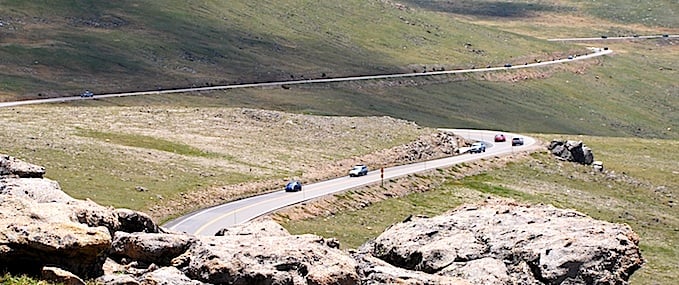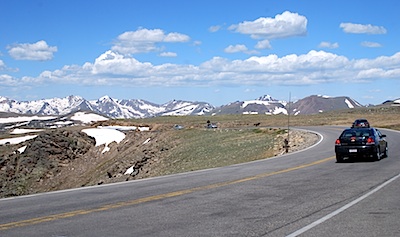
Trail Ridge Road in Rocky Mountain National Park offers no guardrails to keep you from plunging off the mountainside. Kurt Repanshek photo.
Driving Trail Ridge Road in Rocky Mountain National Park is not for those who suffer vertigo. No guardrails will stop your vehicle if you edge off the pavement, and the flanks of the mountains drop away quickly, and steeply.
As the road carves its serpentine path across the park's roof, rising past 12,000 feet in elevation, it can be a struggle to keep your eyes on the pavement in front of you, and not veering to those monstrous dropoffs. And yet, according to park officials, there have been very few fatal accidents along Trail Ridge Road.
"We have a few motor vehicle accidents a year along Trail Ridge Road, but few are fatal," says Rocky Mountain spokeswoman Kyle Patterson. "The last fatality on Trail Ridge Road was in 1995 when two young men drove off near Rock Cut in a bad spring storm."
Why are there no guardrails along the road? The Federal Highway Administration addressed that topic in the "barriers" section of the Trail Ridge Road Safety Study completed back in 2004:
Due to the steep slopes and rigid objects along most of the roadside, barrier is warranted along the majority of the roadway. However, there are several reasons why this is not recommended.
First, there are very few accidents occurring where guardrail or stone masonry wall would result in less injuries and property damage for the motorists. The crashes involving motorcycles would likely result in worse injuries if a barrier were in place. Outside of the alpine areas, vehicles that run off the roadway are generally stopped a short distance from the roadway by trees and due to the low speeds there are relatively minor injuries. If a barrier on this curvy road had redirected these vehicles, it is quite likely they would go across the other lane of traffic and possibly have a more serious accident or involve an innocent bystander in the crash.

Spectacular scenery can make it a challenge to keep your eyes on the road. Kurt Repanshek photo.
With barriers on both sides of the road, they may ricochet back and forth across the lanes before coming to a stop. In the alpine section where the need appears greatest because of the sheer distance down the steep slopes, there are very few run-off-road accidents. This may be due in part to the extra care that drivers take due to the fear instilled by the sight of these slopes.
Second, the views from the roadway would be partially blocked by the barrier. Considering that the main purpose of this roadway is to provide tourists with the amazing vistas of this area, blocking views would take away from the very purpose of this road. This is not to say that blocking a view is more important than providing a safe roadway, but that installing barrier along both sides of the entire length of this roadway would not be worth the trade-off. (Trail Ridge Road was designated by the U.S. Secretary of Transportation as an All-American Road, the highest level of designation, in 1996. It is one of eleven America’s Byways® designated in Colorado).
Third, the cost and environmental impacts would be great. Because barrier by its very nature requires a wider roadway footprint, the cost of installing barrier on this narrow roadway would require retaining walls along most of the fill slopes. In addition, it was noted that many of the areas that most warrant barrier are areas that are already narrow with very steep slopes that extend for hundreds of feet.



Comments
25 mph
I've drove it a dozen times. When your driving, dont get distracted by the scenery. If you want to see that; Stop and look. Also the winds can be strong. Downshift and dont 'ride' the brakes all the way down. Use the brake firmly, then let up to gain speed, then apply again, then let up. This allows the brakes to cool. Stop a few times and let your car idle, dont shut it off too soon, it may boil over. If your too scared to drive, then dont try it. But for most its not that bad. Even I kinda white nuckle it.
Glad I got to see it to the top, but it's not something I would do again.
I was in the passenger seat and don't think I could have driven.
The ride does offer spectacular views and since we had been staying in Winter Park
prior to making the drive, we were used to the altitude.
I think I was more concerned for the bike rider who was in front of us
on the way down than for my own safety!
Drove it today and was scared out of my mind. Went really slow, and used almost every turnout available to be courteous. At the highest areas, there are few-to-none turnout areas, and other drivers can be just plain mean on the road. You'd think Texas plates would be a good indicator that the driver would have very little experience driving that type of road. Would not recommend the drive to anyone scared of heights, or who ever gets dizzy. I could not take my eyes off of the pavement the entire drive, and the scenic overviews only serve to remind you just how far down you really can roll.
In my recent visit, 30MPH or less is quite common. No one seems to be in a hurry and there are plenty of places to pull off and let those who want to drive faster, get by you.
Did this just days ago- in a jeep tour. Luckily I wasn't driving. My brother and sister-in-law returned the following day to drive it thru to Grand View Lake. I would not go- it would not have been fun for me. I have lived too long in CA with PCH to know that there are always always always things that happen that are out of the ordinary and can cause an instant fatality. Yes it is a stunning view, but driving above the tree line is not for me.
Did this trail today in a Jeep and had I been in anything else bigger not sure how I would've done. Fellow drivers were pretty great as on the way up, you have the right of way - so I hugged the yellow line very generously and others going down On the other side moved a bit to the right to accommodate me. Was solo doing this which probably didn't help. Got a handful of pictures but unfortunately not as many as I wanted - if you are driving you don't have the luxury of looking left or right until you pull over. If you are driving up, DO NOT LOOK TO THE RIGHT if you have Issues with vertigo.
Went last week and it was terrible could not enjoy the scenery. We were petrified and could only go 5mph and patialy on the wrong side of the road. It took me two days to calm down. i have been to Yellowstone and Glacier and they are fine but this is horrible. I was sweatting like mad. If it had barriers like Going to the Sun in Glacier it would have been fine. It is unbelivable that its ok to make a road this dangerous.